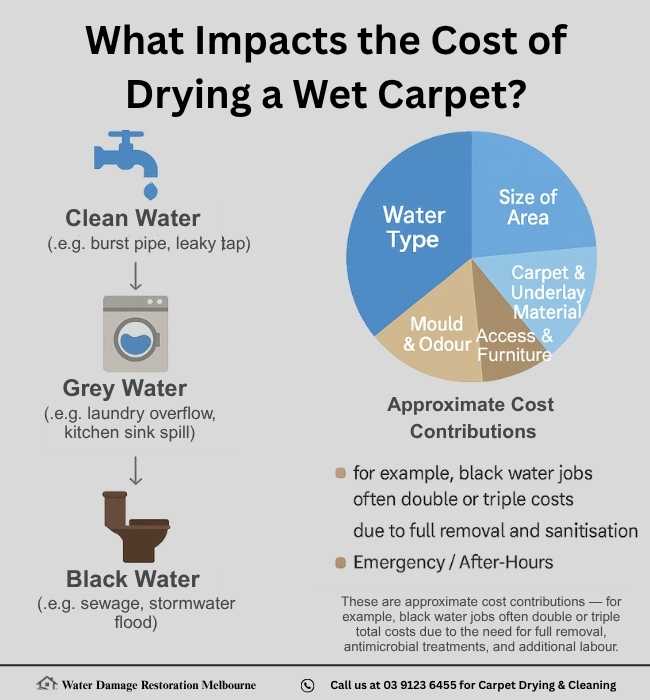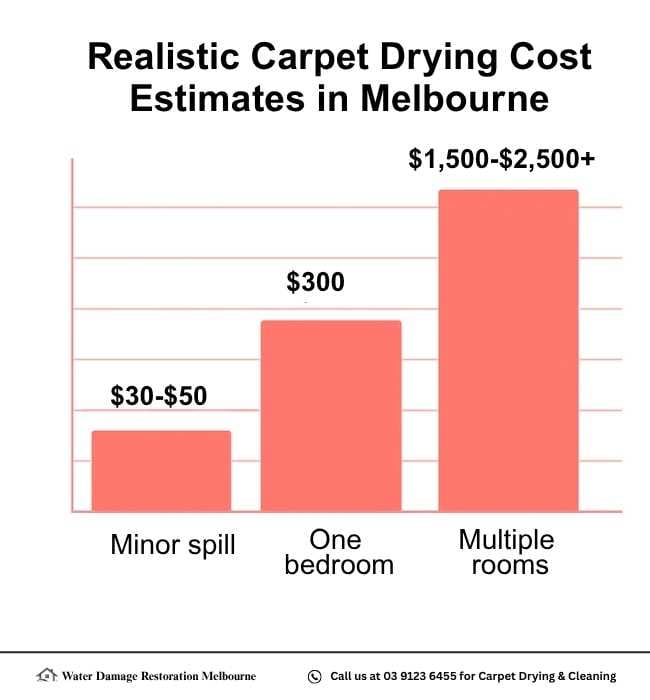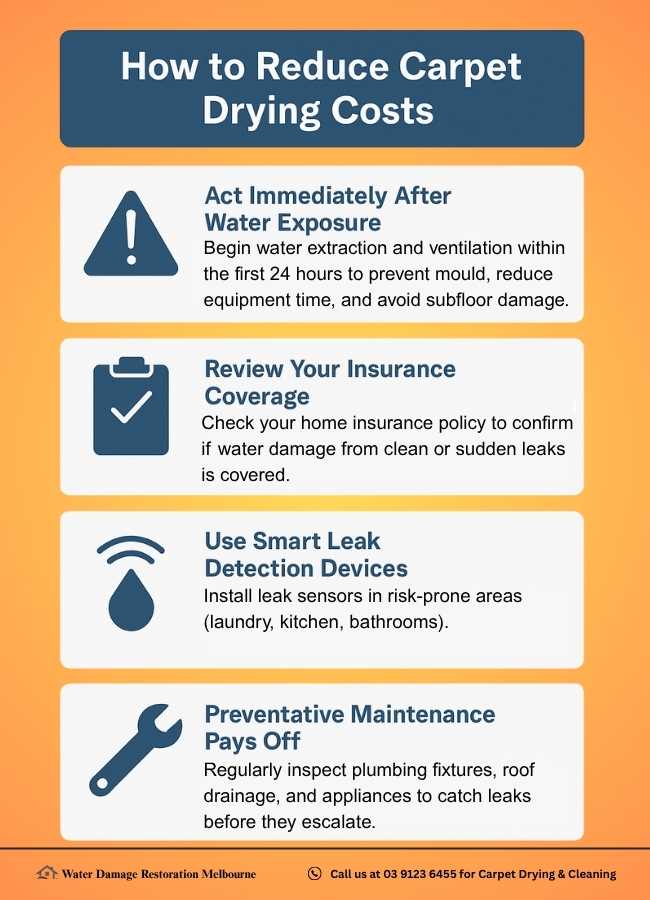At Water Damage Restoration Melbourne, we help homeowners across the city dry and restore their carpets quickly and professionally. With years of experience and expert equipment, we know how to handle clean water spills, storm floods, or even black water emergencies.
In this guide, you’ll learn what affects the cost of drying a wet carpet, what price range you might fall into, and when it’s time to call in the pros. We’ll keep things simple, honest, and useful no confusing jargon here.
Table of Contents
ToggleKey Takeaways
- Water type matters: Clean water from a tap is cheaper to handle than grey or black water, which requires disinfection or full carpet removal.
- Size and depth impact pricing: Small spills can cost as little as $30–$50, while full-home flooding may range between $1,500–$2,500+, especially if water has reached the underlay or subfloor.
- Carpet and underlay materials affect drying: Wool carpets and absorbent underlays retain more moisture, increasing drying time and cost. Synthetic carpets dry faster and are easier to restore.
- Mould and odour increase costs: If water damage is left untreated, mould remediation and deodorisation will add to the final bill.
- Access issues add labour time: Tight spaces, stairs, or bulky furniture may require extra setup time, increasing overall labour costs.
- Emergency or after-hours services may carry a premium: Quick response prevents escalation but can incur higher call-out fees outside standard hours.
- Preventative steps save money: Acting fast, checking your insurance, and installing leak detectors can reduce restoration costs significantly.
What Impacts the Cost of Drying a Wet Carpet?

1. Type and Source of Water
The type of water involved in carpet flooding significantly impacts both the health risk and the cost of restoration.
- Clean water, typically originating from a burst pipe, leaky tap, or indoor plumbing fault, is the least hazardous and generally the most affordable to manage. If identified early, drying clean water damage often requires minimal intervention.
- Grey water is commonly from laundry overflows, kitchen sinks, or shower drains which contains contaminants like detergents, grease, or organic debris. It poses moderate health risks and requires careful disinfection.
- Black water is the most dangerous which results from sewage backups, stormwater intrusion, or toilet overflows. This category is highly unsanitary and often requires full carpet and underlay removal due to the presence of harmful bacteria and pathogens.
According to the ANSI/IICRC S500 Standard for Professional Water Damage Restoration, water damage is classified into clean, grey, or black water categories, each requiring specific safety precautions and restoration procedures.
Insight: In our Melbourne jobs, we often see homeowners assume grey water from a kitchen or laundry is ‘safe’; but it can contain grease, bacteria, and detergents that require careful disinfection, not just drying.
2. Size of the Affected Area
The size of the affected carpeted area plays a major role in determining the overall cost of drying and restoration.
A small surface spill (less than 1 square metre) caused by clean water can often be resolved for as little as $30 to $50, using basic extraction methods. However, a single water-damaged room (approximately 13 square metres) typically costs around $300, especially if the carpet underlay is affected.
For larger incidents, such as multi-room flooding or whole-home water intrusion, costs can escalate to $1,500–$2,500+, depending on the water category and how deeply it has penetrated into the underlay and subfloor.
Water doesn’t remain static, it spreads quickly through carpet padding and can even wick into timber flooring or concrete slabs due to capillary action. This makes fast, strategic water removal essential for reducing labour and equipment time and ultimately minimising restoration costs.
3. Material of the Carpet and Underlay
The type of carpet fibre and underlay material significantly influences how quickly and effectively a water-damaged carpet can be restored.
Wool carpets, made from natural fibres, are highly absorbent and tend to soak up large volumes of water rapidly. This increases both the drying time and the likelihood of mould development, making wool more complex and costly to restore.
In contrast, synthetic carpets such as those made from nylon or polyester are more water-resistant and dry faster due to their lower hygroscopic rating (the material’s tendency to retain moisture). These fibres are commonly found in modern homes and commercial settings, making them more manageable during emergency drying.
Additionally, the carpet underlay whether foam, rubber, or felt can also impact restoration time, especially if it absorbs and traps water against the subfloor, potentially requiring full replacement.
4. Equipment and Time Required
- Air Movers – High-velocity fans that increase evaporation speed by circulating air across the carpet and underlay.
- Dehumidifiers – Industrial-grade units that extract excess moisture from the air, critical for reducing humidity levels and preventing mould growth.
- Moisture Meters – Tools used to detect hidden moisture in carpet fibres, padding, and subfloors; ensure complete drying before reinstallation or cleaning.
- Drying Duration – Typically ranges from 3 to 5+ days, depending on factors like, water saturation depth, type of carpet and underlay, indoor humidity levels, external weather conditions.
5. Presence of Mould or Odour
The presence of mould spores or persistent odours indicates that water damage has progressed beyond surface-level saturation, often requiring additional remediation steps. If mould is detected, certified technicians must apply antimicrobial treatments to neutralise fungal growth on both the carpet fibres and underlay.
In some cases, strong smells may require the use of professional-grade deodorisers to restore indoor air quality. When contamination is severe, sections of the carpet, padding, or even subflooring may need to be removed and replaced.
These extra tasks increase labour time and equipment use, pushing the overall restoration cost higher especially for black water incidents or prolonged moisture exposure.
Insight: We’ve found many Melbourne homeowners delay calling after noticing a musty smell, thinking it will go away. But mould often spreads unseen under the carpet and underlay within 48 hours, requiring a full antimicrobial treatment.Have a Mould Problem? Schedule Your Inspection ➔
6. Access and Furniture
The layout and accessibility of the affected space play a significant role in determining the total cost of carpet drying. Rooms filled with heavy furniture, tight hallways, or multi-storey access points (such as stairs) typically require additional labour to move, protect, or navigate around obstacles.
Restoration technicians may need to use furniture sliders, apply plastic sheeting to safeguard upholstery, or disassemble larger items to reach wet areas. These logistical challenges can prolong setup time and increase the complexity of drying operations, especially when air movers, dehumidifiers, and moisture detection equipment must be carefully positioned across limited space.
7. Emergency Response & After-Hours Work
Rapid intervention is critical in water damage scenarios, as it can significantly reduce both the extent of carpet saturation and overall restoration costs. Delaying action allows clean water to degrade into grey or even black water, increasing health risks and requiring more intensive remediation.
Professional emergency carpet drying services are available 24/7 to mitigate these risks, but after-hours call-outs including nights, weekends, and public holidays, may incur premium labour fees due to urgent mobilisation and limited technician availability.
However, the cost of acting fast is often far less than the price of delayed response and secondary damage, such as mould growth or subfloor replacement.
Need fast help?
Don’t wait for water damage to get worse. Our team is available 24/7.
Request Immediate Assistance ➔8. How Melbourne’s Climate Impacts Carpet Drying Costs
Melbourne’s unique climate and environmental conditions directly affect how much you’ll pay for carpet drying and water damage restoration. Here’s how local weather, humidity levels, and extreme events factor into the equation:
- Frequent Weather Swings Across Melbourne: Melbourne is known for its “four seasons in one day”, with rapid shifts between sunshine, rain, and cool winds. These changes impact indoor humidity, slowing evaporation and requiring more use of commercial dehumidifiers, high-speed air movers, and moisture meters. A sudden thunderstorm can add unexpected equipment and electricity costs.
- High Summer Humidity in Victoria: During summer, Melbourne often records 60–70% relative humidity, especially in bayside suburbs like St Kilda and Brighton. This hampers natural carpet drying and makes industrial-grade drying equipment a necessity, increasing both labour costs and machine rental fees.
- Cold, Damp Winters in Southern Australia: Melbourne’s winter climate, marked by frequent rain, low temperatures, and high indoor dampness, means drying times can double without supplemental heating. Restoration companies may need to deploy portable heaters, dehumidifiers, and thermal imaging cameras to locate hidden damp spots, all of which add to the final bill.
- Storm and Flood Events in Melbourne Suburbs: Recent years have seen more flash floods in areas like Maribyrnong, Essendon, and Footscray. After these events, water is often classified as Category 3 (black water), containing mud, sewage, and bacteria. This escalates the project from standard drying to full flood damage remediation, underlay removal, sanitisation, and HEPA vacuuming, significantly increasing overall costs.
Insight: Melbourne’s unpredictable weather like sudden storms after a heatwave often leads to flash flooding with black water contamination. Many homeowners are surprised that this isn’t just a ‘dry and clean’ job but a full Category 3 flood remediation.Worried About Flooding? Contact Us ➔
Realistic Carpet Drying Cost Estimates in Melbourne

Carpet drying costs in Melbourne vary based on the severity and size of the water damage. A minor clean water spill affecting less than 1 square metre may cost as little as $30 to $50, especially when dealt with quickly.
For a standard bedroom or living room (approximately 13 square metres), the average professional drying fee is around $300, including surface extraction and underlay inspection.
In more severe cases such as multi-room flooding or whole-home water damage, costs can range from $1,500 to $2,500+, particularly when grey or black water contamination is involved.
These estimates cover essential services like moisture detection, air movers, dehumidification, and potential antimicrobial treatments.
Carpet Drying Cost Table
| Scenario | Area Size | Water Type | Estimated Cost |
|---|---|---|---|
| Minor spill | <1 sqm | Clean | $30–$50 |
| One bedroom | ~13 sqm | Clean | ~$300 |
| Multiple rooms | 60+ sqm | Grey/Black | $1,800–$2,500+ |
When DIY Carpet Drying Is Safe and Effective
1. Ideal for Minor Clean Water Spills
- Small, localised incidents like a spilled drink or leaky tap.
- Water must be from a clean source (non-contaminated).
2. Basic Tools Are Usually Sufficient
- Use absorbent towels, wet/dry vacuums, and household fans to remove surface moisture.
- Ensure room ventilation by opening windows and doors.
3. Check for Hidden Moisture
- Use or rent a DIY moisture meter to detect water beneath the carpet or in the underlay.
- Monitor for signs of dampness or odour over the next 24–48 hours.
4. Know When to Call a Pro
- If water has soaked into the underlay, affected a large area, or wasn’t removed promptly.
- Professional drying is essential to prevent mould, flooring damage, and health risks.
Learn more: What steps to take when only your carpet is flooded before the damage spreads.
How to Reduce Carpet Drying Costs

1. Act Immediately After Water Exposure
- Begin water extraction and ventilation within the first 24 hours to prevent mould, reduce equipment time, and avoid subfloor damage.
2. Review Your Insurance Coverage
- Check your home insurance policy to confirm if water damage from clean or sudden leaks is covered.
- Document the damage with photos and notify your insurer promptly.
3. Use Smart Leak Detection Devices
- Install leak sensors in risk-prone areas (laundry, kitchen, bathrooms).
- Early alerts can prevent large-scale water damage and unnecessary restoration costs.
4. Preventative Maintenance Pays Off
- Regularly inspect plumbing fixtures, roof drainage, and appliances to catch leaks before they escalate.
- Being proactive helps you avoid emergency call-outs and expensive repairs.
Conclusion:
Wet carpet isn’t just uncomfortable, it’s risky. The Australian Department of Health warns that mould can develop within 24–48 hours in damp conditions. That’s why quick action matters.
At Water Damage Restoration Melbourne, we’re here to help. We offer fast, friendly, expert service across the city. Whether it’s a tap left running or a storm that soaked your floors, our team is ready.
Reach out to Water Damage Restoration Melbourne for fast, professional carpet drying services.
We’ll give you honest advice, transparent pricing, and peace of mind.
Contact Us Now ➔Frequently Asked Questions
Is wet carpet covered by home insurance in Australia?
A wet carpet is often covered by home insurance in Australia. If the water damage is sudden (like a burst pipe). But slow leaks or maintenance issues might not be covered. Check your policy or speak with your insurer.
How do I know if mould is growing under my carpet?
To know if mould is growing under your carpet, you have to watch for musty smells, damp spots, or allergy symptoms. A professional can test moisture levels and lift carpet if needed.
What’s the difference between water extraction and drying?
Water extraction refers to the immediate removal of standing water from the carpet surface using tools like wet/dry vacuums or water pumps. This is the first critical step after flooding.
In contrast, carpet drying is the extended process of eliminating residual moisture trapped deep within the carpet fibres, underlay, and even the subfloor. Drying typically involves the use of high-powered air movers, industrial dehumidifiers, and moisture detection equipment to ensure the space is fully restored and safe from mould growth or structural damage.
Why Is My Carpet Still Dirty After Professional Cleaning?
If your carpet still looks or feels dirty after a professional clean, it could be due to several reasons:
Residual Detergent: Incomplete rinsing can leave behind cleaning agents, which attract dirt faster and make the carpet feel sticky or appear soiled again soon after.
Deep-Set Stains: Some stains like pet urine, wine, or oil can penetrate deep into the carpet padding or fibres and may not be fully removed in a single cleaning session.
Wicking Effect: Moisture and dirt from the underlay or subfloor can resurface as the carpet dries, making it appear as though the stain has returned.
Low-Quality Equipment or Methods: Not all “professional” services use industrial-grade equipment or follow IICRC standards. Subpar machines can leave dirt behind or fail to extract enough water.
Heavy Soiling or Neglect: Carpets that haven’t been cleaned in years or have heavy traffic may require multiple treatments for full restoration.
If your carpet doesn’t look clean after a service, it’s worth discussing it with the provider—or seeking a second opinion from an IICRC-certified technician.





